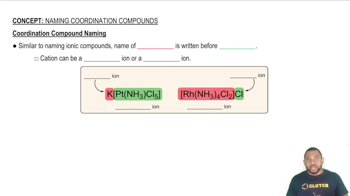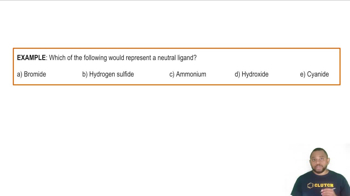Here are the essential concepts you must grasp in order to answer the question correctly.
Werner's Theory of Coordination Compounds
Werner's theory distinguishes between primary and secondary valences in coordination compounds. Primary valence corresponds to the oxidation state of the central metal ion, while secondary valence refers to the number of ligands attached to the metal. This framework helps in understanding the bonding and structure of complex ions.
Recommended video:
Coordination Compound Naming
Ligands and Coordination Chemistry
Ligands are molecules or ions that can donate a pair of electrons to a central metal atom to form a coordination complex. The ability of a substance to act as a ligand depends on its electron-donating capacity and steric factors. For example, NH₃ can donate a lone pair of electrons, while BH₃, being electron-deficient, cannot act as a ligand.
Recommended video:
Oxidation Number
The oxidation number is a concept used to indicate the degree of oxidation of an atom in a compound. It reflects the number of electrons an atom can gain, lose, or share when forming chemical bonds. In coordination chemistry, the oxidation number of the central metal ion is crucial for determining its reactivity and the overall charge of the complex.
Recommended video:
 Verified step by step guidance
Verified step by step guidance

